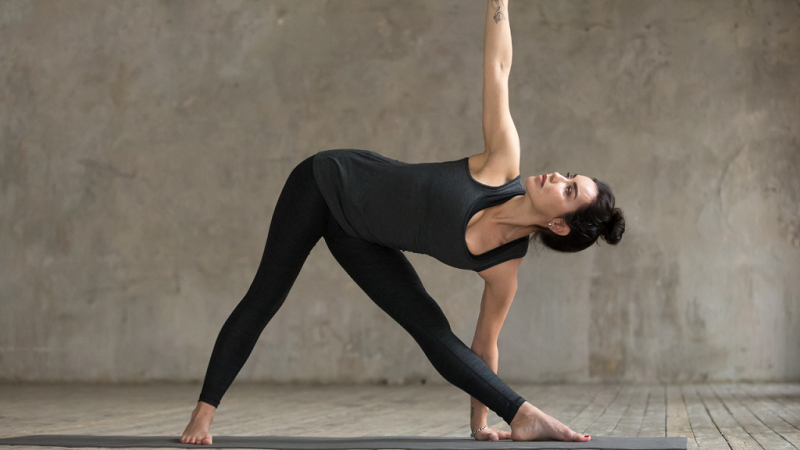Within the world of Trikonasana, there are some variations. All of them offer many benefits for the body and, in addition, to its variations, we can find it as ideal for both initial and advanced yoga practitioners. It is a pose that offers balance and flexibility and a beautiful connection of breath and body. This time we will focus on the triangle pose and the extended triangle, the traditional figures of Trikonasana.
Trikonasana for meditation
Specifically, the extended triangle asana comes from the Sanskrit Utthita Trikonasana. Utthita = extended + Trikona = triangle + Asana = posture. It is important to mention the other variations of the Trikonasana:
- Utthita trikonasana (the fundamental one, which we will talk about in this article and refer to it as trikonasana)
- Baddha trikonasana
- Parivrtta trikonasana
Likewise, different teachers of different yoga traditions have different perceptions. It is about the fundamental points of the trikonasana. Your teacher may teach you shapes that don’t match those of others. Similarly, Iyengar, Ashtanga, Kripalu, Sivananda, and Bikram show different body position options when performing this yoga posture.
Step by Step Trikonasana for meditation
Stand in front of the side edge of your yoga mat, spread your feet about double your hips width.
Rotate the right foot 90 degrees so that the toes of that foot point to the front edge of the mat and the left foot 45 degrees to the right.
Distribute the weight evenly between the four support points on the feet: the arches will have to be raised off the ground and the inner ankles will go up.
With your legs well stretched, take a deep inhalation and as you exhale, rotate your body to the right in a hip movement, making sure to keep your waist firm. The left hand should go up, pointing to the ceiling, while the right hand will look for the ground. Both arms should be in a straight line, perpendicular to the ground.
In this position, it is not important to reach anywhere with your arms. If you can’t touch the ground, the left arm can rest on your ankle or even a little higher if you can’t lower it further. The hip position mustn’t change in the attempt to bring the arms a little further.
Once you have adjusted the position of the hips, waist and arms, look at the fingertips of your left hand.
At this point, with the armed posture, you should verify that your body has not leaned forward or backward. The incline must be lateral only.
Check that both the pelvis and chest are always kept wide open.
On each inhale, stretch a little more, always holding each point of the pose steady. On each exhale, relax your body without losing control of your body position. Feel the connection between your body and each deep breath.
To disarm Trikonasana, inhale and rise from the hips, leaving the arms parallel to the ground. The second step is to lower your arms. Then move your feet so that they are parallel to each other again and bring your legs together.
Repeat all the above process to the left side
Mistakes to avoid:
Don’t worry about how far your arms go. The most important thing is the position of the hips and the firmness in the position.
Widening your legs can make Trikonasana complicated, as well as working the wrong parts of the body. If you feel like you’re having a hard time, you can put your legs together a bit.
The firmness of the position is centered on the points of support of the feet. It is important from the beginning of the pose to have firm feet.
Do not rest your lower arm on your knee, as it will put a hazardous load on it.
Trikonasana benefits
Strengthens the legs and back
Allows stretching of thighs, hamstrings, calves, entire spine, shoulders and chest
Stimulates the opening of the hips
Offers the body energy and balance
Stimulates the abdominal organs
Tips for beginners
A helpful tip to keep your balance is to focus your eyes on a fixed point.
In many cases, newcomers to Trikonasana may find it difficult to look up. If this is your case, relax your head in a neutral position, which is comfortable for you.
You can bring your legs together with a little if you feel excess difficulty in them or the arm position.
Precautions
It is recommended to avoid this pose if you suffer from. If you have knee problems or feel pressure during Trikonasana, you can slightly bend your leg on the side you are leaning on. If you have cervical or neck problems, don’t try to lift your gaze. Instead, relax your head and gaze in a neutral position. Do not rest the arm below your knee since you will apply an excessive load that can have risks.

